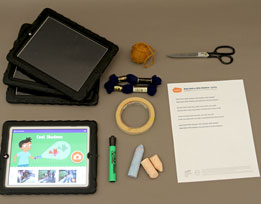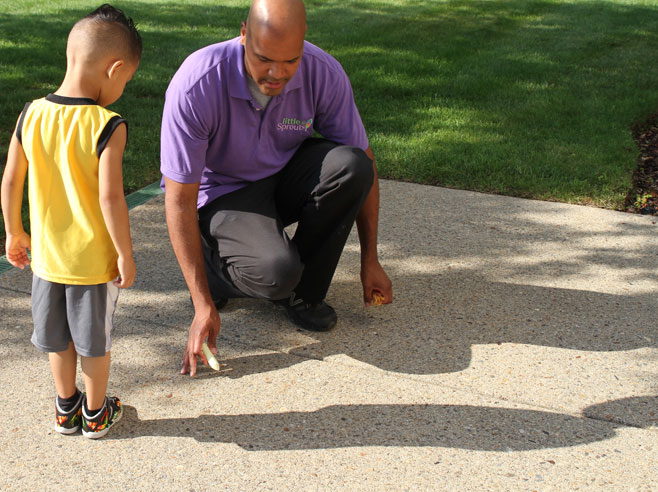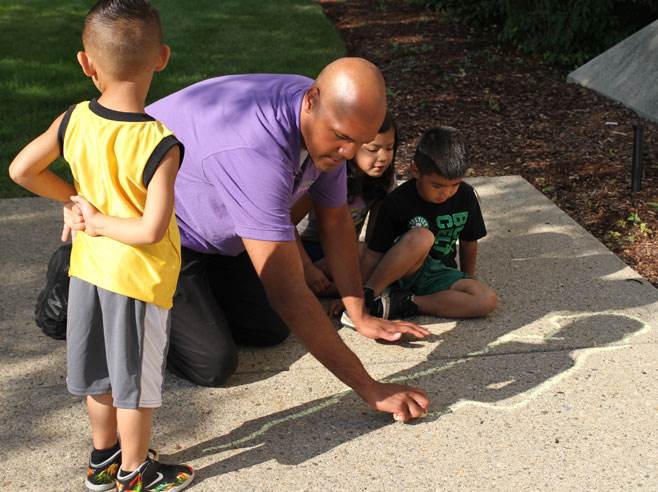Children trace and measure shadows at different times of the day and discover how the location and length of the shadows change. They use the Cool Shadow tool to document their experiment.
Materials

- Cool Shadows tool in the digital Shadows Journal on the iPad
- Jakob Had a Little Shadow: Lyrics (PDF)
- Marker
- Sidewalk chalk, 2 colors
- Scissors (for teacher and/or children)
- Yarn, 2 colors matching the 2 chalk colors, if possible
- Optional: masking tape
Preparation
- Visit your outdoor play area or other safe outdoor location at different times of day to preview the shadows that can be seen and determine if any of those shadows are in places where the children can trace them. Is there a place where children can stand to have their own shadows traced? Will that area be in the sun in the morning? At midday? In the afternoon?
Directions: Lessons 8, 11, 12
Outdoors
- This activity is based on the Shifting Shadows video. Over the course of one or two days, go outdoors as a class or in small groups at two or more times of day—for example, early in the morning and at noon, or at noon and late in the afternoon.
- Trace each child’s shadow with chalk. Label each tracing with the child’s name and the time of day. Also trace around the child’s feet so that s/he can stand in the same spot, facing the same way, the next time you come out.
- Measure the length of the shadow, from foot to head, with yarn. Cut the yarn to match the length of the shadow and attach a masking tape label with the child’s name and time of day. Hold the yarn up to the child to compare with the child’s actual height. Is the shadow taller or shorter than the child? Collect and save children’s yarn pieces.
- Optional: Show children how they can wrap their piece of measuring yarn around their arm like a bracelet and secure it with a small piece of tape. Then, when they go back out again to check their changing shadow, they will have the yarn with them to compare to the length of their new shadow.
- Compare children’s shadows. Later, repeat the tracing activity of children’s shadows. Go out at a different time of day and use a different color of chalk. If you are using yarn to measure the length of the children’s shadows, try to use yarn that matches the color of the chalk. Compare the two tracings and two yarn lengths.
- How has the shadow changed?
- Why has it changed?
- Document children’s tracings. Help children use the Cool Shadows tool in the Shadows Journal app to take a photo of a classmate with the new shadow tracing overlapping the old shadow tracing.
- Discuss the photos. Which shadow is taller: the shadow we can see now, or the shadow that we traced earlier? Why do you think the two shadows are different?
- Sing “Jakob Had a Little Shadow” about the shadows in the photographs. Sing this song to the tune of “Mary Had a Little Lamb.” Use the name of the children whose shadows are in the photographs. Add gestures to go with the song. Encourage children to join in first with the gestures and then with the words.
- (Child’s name) had a little shadow, little shadow, little shadow.
(Child’s name) had a little shadow; she watched it shrink and grow. - At noontime it was very small, very small, very small.
At noontime it was very small; it almost wasn’t there at all. - In the evening it was very tall, very tall, very tall.
In the evening it was very tall; it stretched to the top of a wall. - (Child’s name) had a little shadow, little shadow, little shadow.
(Child’s name) had a little shadow; she watched it shrink and grow.
- (Child’s name) had a little shadow, little shadow, little shadow.
- Extension: Trace and compare the shadows of outdoor objects. Each time you go out, encourage children to observe and trace shadows of stationary objects, such as playground equipment or a bench. Possible discussion ideas:
- Are the shadows the same shape and size as the objects?
- How are they different? Which one is taller? Shorter?
- Compare the shadows seen later in the day to the shadow tracings made earlier in the day. How have the shadows changed?
- Document the outdoor objects’ shadows. Help children use the Cool Shadows tool in the Shadows Journal app to take photos of the objects with the new shadow overlapping the old shadow tracing.
The photos taken during this activity will be reviewed later as a class, during the Tracing & Measuring Shadows Review Circle Time: Wrap-Up activity in Lesson 9.


